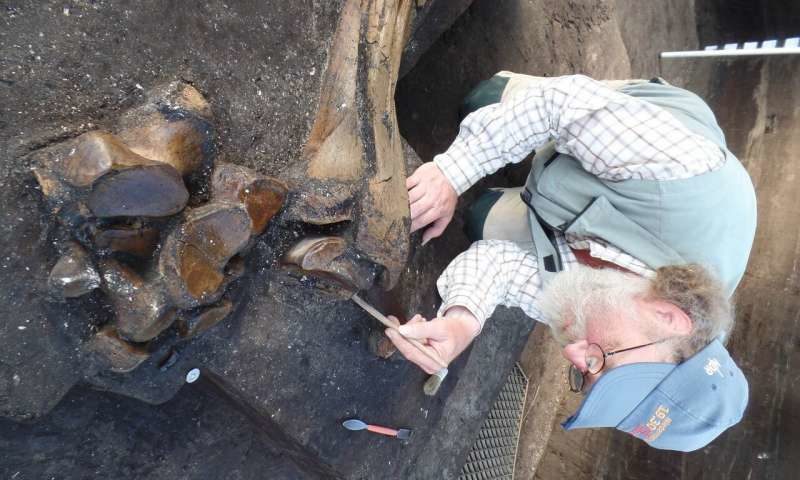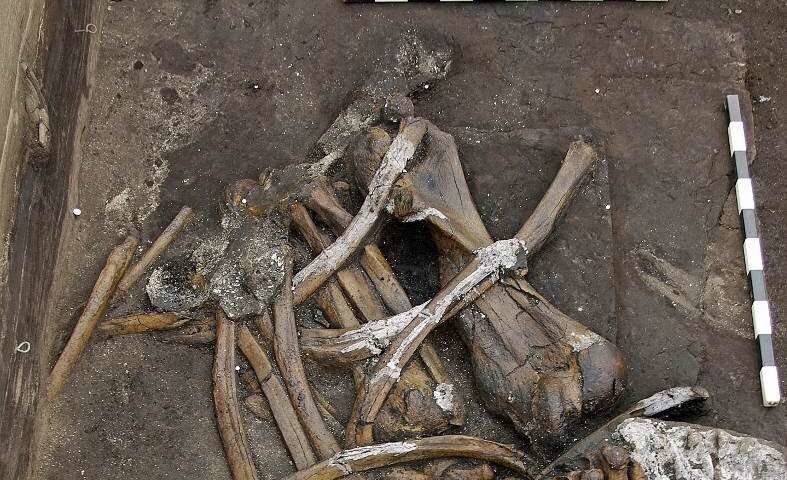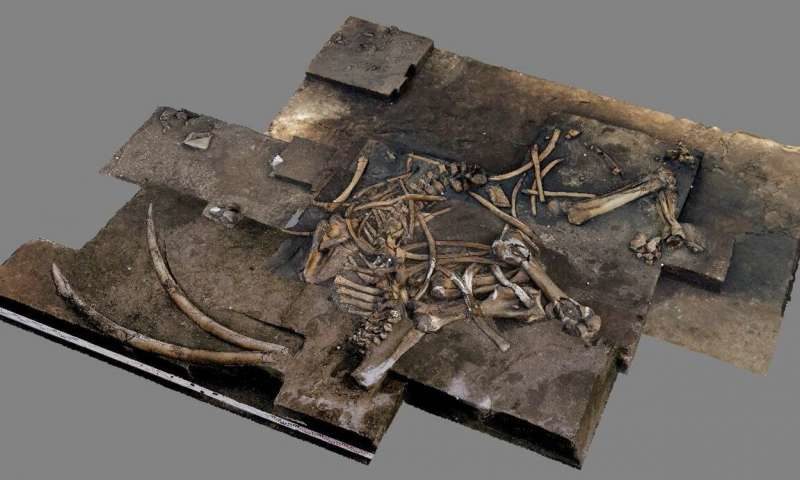
Björn Thümler, Minister of Science of Lower Saxony, says: "The former Schöningen open-cast mine is a first-rate archive of climatic change. This must be made even clearer in the future. This is a place where we can trace how humankind went from being a companion of nature to a designer of culture."
The elephant skeleton lies on the 300,000 years old lakeshore in water-saturated sediments. Like most of the finds at Schöningen, it is extraordinarily well preserved as Jordi Serangeli, head of the excavation in Schöningen explains. "We found both 2.3-metre-long tusks, the complete lower jaw, numerous vertebrae and ribs as well as large bones belonging to three of the legs and even all five delicate hyoid bones."
The elephant is an older female with worn teeth, as archaeozoologist Ivo Verheijen explains. "The animal had a shoulder height of about 3.2 metres and weighed about 6.8 tonnes — it was therefore larger than today's African elephant cows."
It most probably died of old age and not as a result of human hunting. "Elephants often remain near and in water when they are sick or old," says Verheijen. "Numerous bite marks on the recovered bones show that carnivores visited the carcass." However, the hominins of that time would have profited from the elephant too; the team found 30 small flint flakes and two long bones which were used as tools for knapping among the elephant bones. Bárbara Rodríguez Álvarez was able to find micro flakes embedded in these two bones, which proves that resharpening of stone artefacts took place near to the elephant remains. She also refit two small flakes, this confirms that flint knapping took place at the spot where elephant skeleton was found.

Several archaeological sites in the world have yielded bones of elephants and stone artefacts, e.g. Lehringen in Lower Saxony, Bilzingsleben in Thuringia, Gröbern in Saxony-Anhalt, Benot Ya'aqov in Israel, Aridos 1 and 2 as well as Torralba and Ambrona in Spain, Casal dei Pazzi in Rome, Cimitero di Atella, Poggetti Vecchi in Italy and Ebbsfleet in England. Some of these sites have been interpreted as examples of elephant hunts in the Lower or Middle Palaeolithic. "With the new find from Schöningen we do not seek to rule out that extremely dangerous elephant hunts may have taken place, but the evidence often leaves us in some doubt. To quote Charles Darwin: 'It is not the strongest that survives, but the one who can adapt best'. According to this, the adaptability of humans was the decisive factor for their evolutionary success and not the size of their prey."
The fact that there were numerous elephants around the Schöningen lake is proven by footprints left behind and documented approximately 100 meters from the elephant excavation site. Flavio Altamura from Sapienza University of Rome who analysed the tracks, tells us that this is the first find of its kind in Germany. "A small herd of adults and younger animals must have passed through. The heavy animals were walking parallel to the lake shore. Their feet sank into the mud, leaving behind circular tracks with a maximum diameter of about 60 centimetres."
The Schöningen sites have already provided a great deal of information about plants, animals and human existence 300,000 years ago during the Reinsdorf interglacial. The climate at that time was comparable to that of today, but the landscape was much richer in wildlife. About 20 large mammal species lived around the lake in Schöningen at that time, including not only elephants but also lions, bears, sabre-toothed cats, rhinoceroses, wild horses, deer and large bovids. "The wealth of wildlife was similar to that of modern Africa," says Serangeli.

Further detailed analyses of the environmental and climatic conditions at the time of the elephant's death are taking place at the Technische Universität Braunschweig, the University of Lüneburg and the University of Leiden (The Netherlands). The excavations in Schöningen are financed by the Ministry of Science and Culture of Lower Saxony.



Comment: See also: